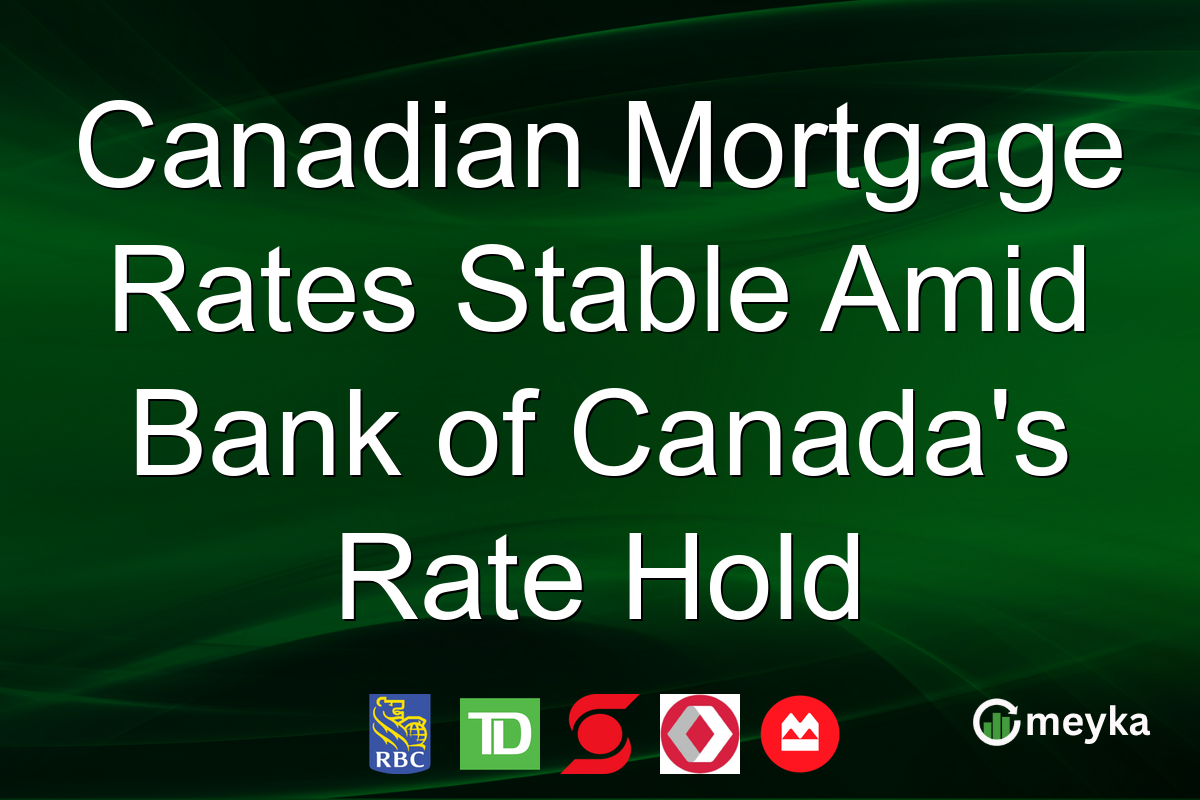Canadian Mortgage Rates Stable Amid Bank of Canada’s Rate Hold
The Bank of Canada’s recent decision to maintain its benchmark interest rate at 2.75% has provided stability in Canadian mortgage rates today. Despite economic uncertainties, this move aims to balance inflation control with economic growth. The impact is visible across major banks like RY, TD, and BNS, with mortgage markets reflecting this stability.
Stability in Canadian Mortgage Rates Today
The Bank of Canada’s decision to hold rates steady at 2.75% is pivotal in maintaining stable mortgage rates across Canada. This decision comes amid ongoing economic challenges, including inflationary pressures and global market volatility. The stability in rates provides a respite for potential homeowners and those looking to refinance. Major Canadian banks have reacted by keeping their mortgage rates relatively unchanged. For example, TD Bank has reported only a minor price change of -0.03%, reflecting market confidence in the current financial policies. Meanwhile, the market capitalization of TD stands at $134.5 billion, underlining its substantial position in the banking sector. The broader strategy is to support housing markets without overheating the economy, a critical balance that the Bank of Canada seeks to maintain. According to an article on Reuters, the decision aligns with Canada’s long-term economic objectives, encouraging steady growth without escalating inflation risks.
Market Reactions and Stock Performance
Market reactions have varied among the country’s top banking institutions. Royal Bank of Canada (RY) has seen its stock price slightly dip by 0.68%, settling at $144.14. Despite this, RY maintains a robust market cap of over $203.3 billion and continues to be a major player in the financial sector. On the other hand, Bank of Nova Scotia (BNS) recently reported a stock price change of -1.40%, bringing its value to $63.38. With a market cap of approximately $78.8 billion, BNS is focused on international expansion that aligns with its strategic growth objectives. These fluctuations demonstrate the nuanced impact of the Bank of Canada’s policy on individual bank stocks, as they navigate through the current market conditions. Such performance metrics indicate investors’ cautious optimism in the banking sector’s ability to adapt to economic changes, a sentiment echoed by analysts and market experts.
Economic Implications of the Rate Hold
The decision to hold rates is more than just a monetary policy move; it’s a strategic alignment with broader economic goals. By maintaining the interest rate, the Bank of Canada aims to stabilize the housing market and keep borrowing costs manageable. For banks like the Bank of Montreal (BMO), which is trading at $126.31, the rate hold represents a potential for steady financial returns. With a PE ratio of 15.33 and a dividend yield of 3.57%, BMO remains a strong investment choice for those seeking income stability. This strategic interest rate position supports banks in managing their loan portfolios, particularly mortgages, which form a major component of their lending activities. Furthermore, according to FT Report, the economic forecasts suggest a gradual growth in mortgage uptake, driven by favorable borrowing conditions maintained by consistent rate policies.
The Role of Major Banks in the Current Scenario
Canada’s major banks play a crucial role in interpreting the Bank of Canada’s rate policies and translating them into consumer rates. Banks like Canadian Imperial Bank of Commerce (CM), currently priced at $79.16, have strategically positioned their mortgage offerings to align with market expectations. CM’s market strategies include leveraging its strong 13.22 PE ratio and a notable market cap to foster consumer confidence in mortgage products. Additionally, Royal Bank of Canada’s revenue per share of over $96 highlights its financial health and ability to channel resources effectively towards sustaining attractive mortgage products. By maintaining competitive mortgage rates, these banks not only support domestic housing markets but also strengthen their investment appeal. This approach ensures that the banking sector remains resilient and adaptable to potential shifts in financial landscapes, further solidifying Canada’s economic stability.
Final Thoughts
The Bank of Canada’s decision to hold interest rates steady at 2.75% has stabilized Canadian mortgage rates today. Major banks, including RY, TD, and BNS, mirror this stability through their mortgage offerings and market strategies. As we navigate ongoing economic challenges, platforms like Meyka provide invaluable insights into real-time market analysis and predictive analytics, essential for investors seeking informed decisions. With Meyka, staying ahead in this dynamic environment becomes manageable and strategic. Stay informed, invest wisely, and leverage the available tools for optimal—M
FAQs
The Bank of Canada’s rate decision directly influences borrowing costs. By maintaining rates, it stabilizes mortgage interests, making borrowing more predictable for consumers.
Stable mortgage rates can encourage home buying and refinancing, providing stability and encouraging investment in the housing sector, boosting economic growth.
Banks like RY and TD use their financial strength and market influence to set competitive mortgage rates, playing a key role in shaping the housing market dynamics.
Disclaimer:
This is for information only, not financial advice. Always do your research.






